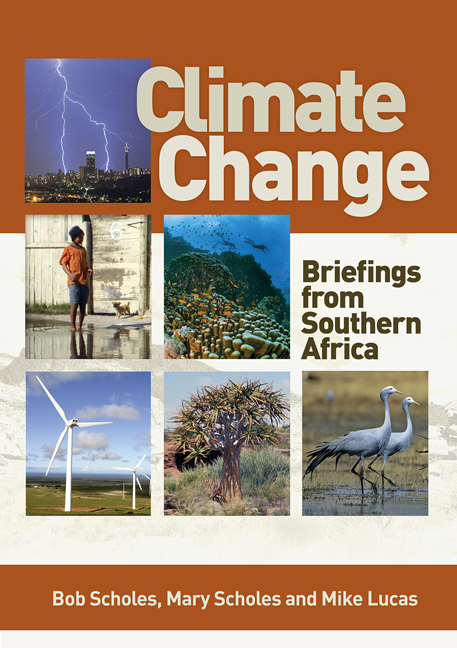Book contents
- Frontmatter
- Acknowledgements
- Contents
- Foreword
- Acronyms and abbreviations
- Preface
- How do governments assess climate change?
- Section 1 Earth system science: The processes that underlie climate change
- Introduction
- 1 Why is Earth habitable?
- 2 How do greenhouse gases regulate Earth's temperature?
- 3 Is water vapour the most important greenhouse gas?
- 4 Why are clouds the wild card in climate change?
- 5 Is climate change just part of a long-term natural cycle?
- 6 Are climate variations just due to volcanoes or other Earth processes?
- 7 How do El Niño and La Niña events affect South African weather?
- 8 How hot might it get in South Africa this century?
- 9 How might the rainfall in Southern Africa change in the twenty-first century?
- 10 Are extreme weather events related to climate change?
- 11 How do land-use changes and deforestation affect global warming?
- 12 What is South Africa's contribution to global warming?
- 13 What happens to carbon dioxide emissions?
- 14 Can ecosystems keep sucking up carbon dioxide from fossil fuel burning?
- 15 Could ocean currents slow down or change direction?
- 16 Is there any chance of runaway global warming?
- Section 2 Consequences of a changing climate for the Southern African environment
- Section 3 Consequences of a changing climate for society
- Section 4 What we can do to avoid and adapt to climate change
- Codicil Is there a dangerous level of climate change?
- Glossary
- List of figures
- References
- Reading list
- Index
Introduction
from Section 1 - Earth system science: The processes that underlie climate change
Published online by Cambridge University Press: 20 April 2018
- Frontmatter
- Acknowledgements
- Contents
- Foreword
- Acronyms and abbreviations
- Preface
- How do governments assess climate change?
- Section 1 Earth system science: The processes that underlie climate change
- Introduction
- 1 Why is Earth habitable?
- 2 How do greenhouse gases regulate Earth's temperature?
- 3 Is water vapour the most important greenhouse gas?
- 4 Why are clouds the wild card in climate change?
- 5 Is climate change just part of a long-term natural cycle?
- 6 Are climate variations just due to volcanoes or other Earth processes?
- 7 How do El Niño and La Niña events affect South African weather?
- 8 How hot might it get in South Africa this century?
- 9 How might the rainfall in Southern Africa change in the twenty-first century?
- 10 Are extreme weather events related to climate change?
- 11 How do land-use changes and deforestation affect global warming?
- 12 What is South Africa's contribution to global warming?
- 13 What happens to carbon dioxide emissions?
- 14 Can ecosystems keep sucking up carbon dioxide from fossil fuel burning?
- 15 Could ocean currents slow down or change direction?
- 16 Is there any chance of runaway global warming?
- Section 2 Consequences of a changing climate for the Southern African environment
- Section 3 Consequences of a changing climate for society
- Section 4 What we can do to avoid and adapt to climate change
- Codicil Is there a dangerous level of climate change?
- Glossary
- List of figures
- References
- Reading list
- Index
Summary
Global warming is a symptom of a much wider set of changes in the metabolism of our planet. It refers to the increase in the average air temperature near Earth's surface, measured over the past century-and-a-half by weather stations on land and on ships all around the world. Warming is the result of a set of connected changes in the global climate system, which consists not only of the atmosphere, but also the oceans, the cryosphere (the frozen parts of Earth) and the land. Scientists refer to this broad set of disturbances as ‘global change’, which is brought about largely by human activities. They include changes to the composition of the atmosphere caused by emissions of various gases and particles from industry, vehicles, domestic fires and agriculture; changes in how reflective and aerodynamically smooth the land surface is due to the spread of farmlands and cities into previously natural vegetation; changes in the ocean due to pollution, fishing, warming and the increased uptake of carbon dioxide (CO2) from the atmosphere; and the melting of glaciers, ice caps, permafrost, snow cover and sea ice. The symptom these changes produce, acting together, is an unsteady rise in air temperature. There are other signals of a changing world, such as shifts in the seasons, in the amount of rainfall and in the height of sea level relative to the land, as well as increasing acidity of the ocean and severe storms occurring more frequently.
Underlying these worldwide changes is the unprecedented rise to global dominance of our species. Human numbers have grown exponentially since the Neolithic Revolution when we ‘invented’ agriculture by domesticating plant and animal species. Agriculture only became viable after Earth emerged from the last ice age about 10 000 years ago, and entered the era of relatively warm and stable climates known as the Holocene. The next important event in terms of the global impact of Homo sapiens was the Industrial Revolution, when we learned how to exploit the energy in fossil fuels such as coal and later in oil and gas. The industrial era began gradually and its starting date is usually given as about 1750. We only have regular, accurate and direct measurements of Earth's climate since about 1850, and of Earth's atmospheric composition from about 1950. The most dramatic changes have been in the past four decades.
- Type
- Chapter
- Information
- Climate ChangeBriefings from Southern Africa, pp. 1Publisher: Wits University PressPrint publication year: 2015



